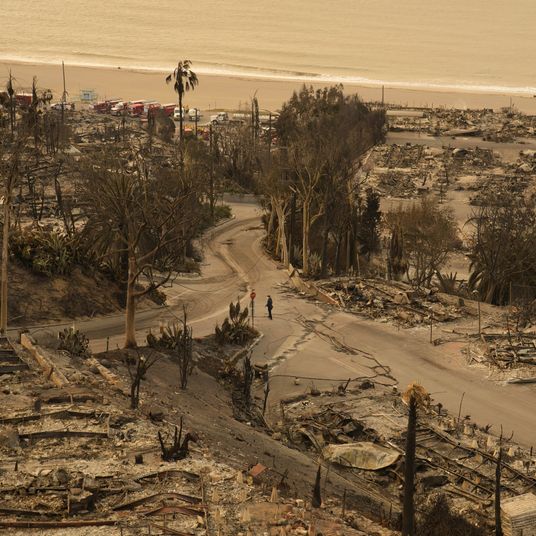
Photo: Getty Images
Today’s big vote isn’t really about who’s going to win the Pennsylvania primary: Barack Obama himself is so sure he’s going to lose that he plans to leave the state for a rally with John Mellencamp in Evansville, Indiana, while Hillary Clinton will be celebrating victory in Philadelphia. (Which means both campaigns will probably play “Small Town.”)
It’s not about delegates, either. The majority of Pennsylvania’s delegates are divvied up by congressional district, with heavily Democratic areas getting more of them, and Obama is likely to score well in these districts. So just like in Texas, even if Clinton wins the overall state by a considerable margin, she is likely to net only a handful of delegates.
And it’s not about Hillary’s oft-repeated claim that only she can carry big states that “matter.” History shows that candidates who lose states in the spring are perfectly capable of winning them in the fall — and vice versa.
Instead, the Pennsylvania primary is all about the popular vote. Obama currently leads Clinton by more than 700,000 votes nationally. But as various other rationales for Clinton’s candidacy have fallen away, a single plausible path remains for her to claim the Democratic nomination: if she collects more total ballots than Obama by the end of the process. On their own private spreadsheets, the Clintonites are already including Florida, adding in Michigan, and discounting various caucuses, ready to pounce the moment Hillary passes Obama’s cumulative count according to any imaginable constellation of numbers. And they realize that Pennsylvania, with about 4 million registered Democrats, is her best shot at reducing Obama’s margin and seizing a mandate.
So what would various victory margins mean?
An Obama win: Recently, Hillary supporters have sublimated their entitlement into a sense of duty: Obama just cannot win, they argue, so we not only have to keep going, we have to take him down. If Obama wins Pennsylvania outright, he will smash that argument to bits. On Wednesday morning, Nancy Pelosi will be at Hillary’s front door and Al Gore at her back door as Howard Dean places the conference call telling her to drop out.
Clinton +1 to +6: Demographically, Pennsylvania should be one of Obama’s very worst states. It’s 82 percent white, full of ethnic Catholics and Scotch-Irish Appalachians. Fifteen percent of the population is over 65 (the third-highest proportion in the country), while just 10 percent is between 18 and 24. And six weeks ago, Obama was down by more than 20 points. If he whittles that margin below Clinton’s lead in the most recent polls, it’s a sign that his campaign got out its vote and wasn’t fatally destabilized by Bittergate or the last debate.
This could happen. Since January 217,000 new voters have registered for the primary. Many of them signed up because of Obama’s organizing drives, and the majority are likely to vote for him. Further, Obama knows as well as Hillary that the popular-vote game is afoot, and last month he started spending a lot of time and money in areas of Philadelphia that he was already likely to carry. He’s hardly liable to gain more delegates in Philly, but he could amass a 150,000-vote margin in the city. There are also areas outside Philly where Obama could poll decently. For example, about 10 percent of the Pennsylvania Democrats live in the state’s South Central region, where cities like Lancaster and Brenner are redeveloping, and where Obama has been just a few points behind Hillary in polls.
If Obama turns out all of these votes and ends up within striking distance of Clinton in Pennsylvania, he’ll keep his popular-vote lead as far as the eye can see. And he could well end the race with victories in North Carolina and Indiana on May 6.
Clinton +7 to +12: Anticlimactic; the various voting blocs fall where expected. Agonizing; vindication for neither side’s tactics. Also, the most likely.
Clinton +13 to +18: A Clinton victory in the neighborhood of fifteen points would embolden Hillary. It would indicate that Obama didn’t fare well anywhere outside of Philly: among women in the suburbs, or New Deal Democrats in Scranton and northeastern Pennsylvania, or voters in old working-class towns, or gun lovers in rural areas across the middle of the state.
That would signal success for Hillary’s negative campaigning and lead her to amp up her attacks even further. It would buy her money and momentum in Indiana. And it would help her run up her totals among Appalachian whites in West Virginia (May 13) and Kentucky (May 20). The campaign, in other words, would stretch on for at least another month.
Clinton +19 or more: A Clinton landslide would not only underscore Obama’s weaknesses among culturally traditional whites. It would wipe out half of his national lead, boosting Hillary’s chances to eventually overtake him in at least some popular-vote calculations. The Puerto Rico primary on June 3 — where a million Democrats could show up at the polls and nobody really knows which way they will break — will then become critically important.
Even if Clinton wins 60 percent or more of the Pennsylvania vote, Obama will be well ahead in delegates. And he’ll still be the favorite to win the nomination, as superdelegates have shown approximately zero inclination to break toward Hillary for more than two months now. But the media will ask: Why didn’t Obamania translate into more votes? And the odds will grow that his knockout punch won’t come in Indiana or Puerto Rico, but at the credentials committee in Denver. —Peter Keating





























